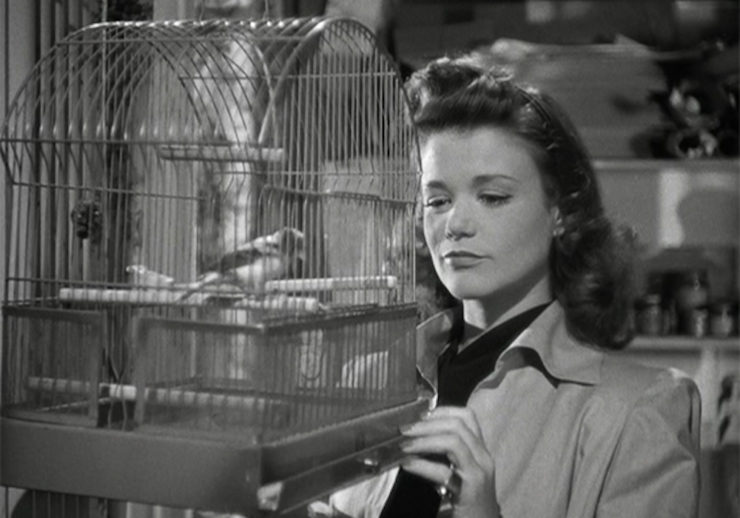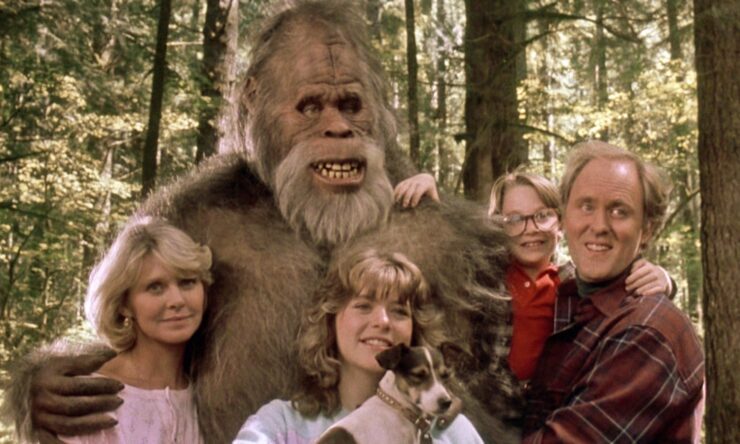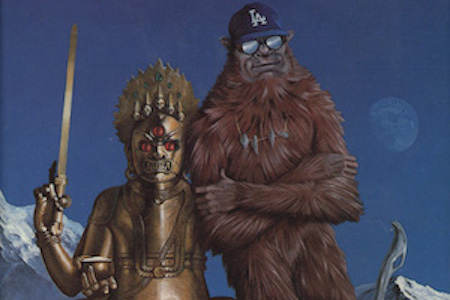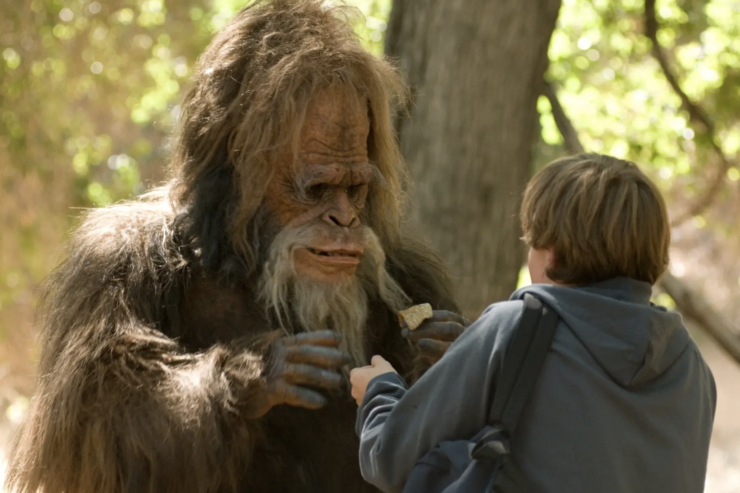This was an interesting experience, or should I say experiment. I had seen the 1982 remake of Cat People, but not the 1942 original. The remake more or less follows the plot outline of its predecessor, but it’s a completely different film.
Cat People 1.0 is about as low-budget as a film can get. It’s filmed in black and white—none of this newfangled and no doubt expensive color—and its stars are definitely not on the A-list. Prolific but not particularly well-known French actress Simone Simon plays the lead, with a supporting cast of non-household names. The special effects are minimal to near-nonexistence.
And yet it’s a classic, and rightly so. It’s a wonderful example of Less Is More. The acting may not be Oscar-quality, but it does what it needs to do.
The plot is as simple and classic as the rest of the film. American engineer and Eastern European immigrant meet-cute at the Central Park Zoo. Adorable Irena Dubrovna is sketching the panther for her job as a fashion illustrator. Handsome ship designer Oliver Reed chats her up, and ends up with an invitation to her huge and gorgeous apartment for tea.
Their affair progresses at lightspeed. Within a couple of days, he’s proposed to her, and she’s accepted.
But there is more to Irena than meets the eye. Her interest in the panther is not simply professional. The village in Serbia where she was born has lived under a curse since the Middle Ages. Its people are descended from witches and devil-worshipers, and the evil persists. Sexual passion, she tells Oliver, causes them to transform into panthers.
Irena marries Oliver, but the marriage remains unconsummated. Oliver clings to patience. Irena gradually slips into what may be psychosis, and what may be the effects of the curse.
Oliver is a thoroughly modern man. He believes that Irena is mentally ill. He dismisses any evidence to the contrary: the kitten he gives her as a gift, who spits and hisses when introduced to her; the way the pet shop erupts into mayhem when they enter it to exchange the kitten for a bird, and calms down completely when she withdraws to the street; the bird’s death from terror when Irena tries to take it out of its cage. Not to mention the very catlike woman in the Serbian restaurant who addresses Irena, in Serbian, as “my sister.”
Irena is alone in the world, but Oliver has a chosen family of coworkers, particularly a young woman named Alice. Alice is in love with Oliver. Oliver is apparently oblivious. They’re just good friends, he tells Irena.
Irena knows better—and jealousy is another form of sexual passion. She begins to stalk Alice. As a cat will. And maybe… as a cat.
The film gives us one of the great jump scares of the genre, building up suspense to the breaking point. Just when we expect either human Irena or panther Irena to attack Alice in the street at night, a bus drives up. Alice is safe. We fall back in our chairs and wait for our hearts to stop pounding.
The pool scene is equally iconic. Alice’s apartment building has a pool in the basement. She comes home late from work and goes for a swim. We hear the growl of the panther. We see Alice’s rising terror. And then Irena appears, purring that she’s looking for Oliver. We all, including Alice, take a deep breath. And then Alice discovers her robe torn to shreds.
Oliver by this time has concluded that Irena needs help. There is a solution, he declares triumphantly. “Psychiatry!”
The dedicated horror aficionado knows where this is going. We’ve seen it in a slew of werewolf movies, including the equally iconic and somewhat earlier The Werewolf of London. The psychiatrist’s “cure” includes blatant sexual harassment, which ends precisely as you would expect, with a scene that does wonders with shadows and sound effects. We never see the actual panther or the actual killing, but we know exactly what’s happening.
The ending is the tragedy we’re set up to expect. Irena frees the panther from its cage with the key she’s stolen from the zookeeper. He mows her down and leaps over the wall, directly in front of an oncoming truck.
In the end, Oliver and Alice stand together over a shadowy heap on the ground. We can just see that the figure that fell as human Irena has died as a panther, still wrapped in her beautiful black fur coat. It’s deceptively simple and beautifully balanced.
The remake, forty years later, enjoys a much larger budget, much more advanced effects technology, and a cast of then and future household names. Nastassja Kinski stars along with John Heard, supported by Annette O’Toole as Alice. It’s in living color, dominated by various shades of blood red. And it’s all just a little bit too much.
Everything here is explicit, from the backstory to the gore to the sex to the transformations. The village moves from Serbia to somewhere considerably more distant and exotic. It looks as much like a severely drought-stricken part of Africa as anything else, but apparently it’s meant to be India. People in the village cross-breed with leopards for Reasons, and the offspring turn into leopards when they attempt to mate with full humans. If they want to return to human form, they have to kill a human. The only way they can stay human permanently once they’ve had sex, we’re told, is to marry each other incestuously: brother and sister mated for life.
Hello, raunchy Eighties. Irena from Serbia is now Irena Gallier from New Orleans. She has a brother named Paul, played by Malcolm McDowell; he lives in a vintage mansion with a Creole housekeeper played by Ruby Dee. Her name is Female (pronounced with a French accent): she was an orphan and the woman who fostered her never bothered to name her, just called her by the entry on the official form.
Oliver is now Oliver Yates, the name Oliver Reed having been taken in the meantime by an A-list star of the period (who had also starred in an iconic shapeshifter film), and he’s now a zookeeper. Alice is his assistant, as is new character Joe, played by Ed Begley, Jr. There’s no psychiatrist, but there is a hard-boiled police detective investigating a series of murders of prostitutes. One of which we get to see in full and gory color, along with her murderer: a huge black panther.
Oliver and Alice capture the panther and lock him up in the zoo. Adorable Irena meanwhile is touring the city; she’s newly arrived, having been sent into foster care as a small child after the death of her parents, but now she’s grown up and she’s come home. Her brother has been living in New Orleans for years. While Irena grew up with normal adoptive parents, he spent most of his childhood in mental institutions—thereby illustrating the futility of psychiatry as a cure for the curse of the cat people.
We get some of the iconic scenes from the original: the bus scare, the pool and the shredded robe, the dead panther, though this time it’s Paul, and Alice has shot him. There’s a little Easter egg in one scene, a cluttered room with an empty birdcage that recalls the one in original Irena’s apartment. But auteur Paul Schrader is not into either simplicity or subtlety. He slathers on the blood, fills the mansion’s basement with dismembered and decomposing bodies, and adds an extra layer of gross. A side effect of the transformation from panther into human is globs of slime with occasional lumps and grit, which Paul makes a production of consuming after one of his changes.
Paul gets the tragic ending, with special bonus green outgassing and slime-covered human arm thrusting out of the panther during necropsy, culminating in the body’s melting into a puddle of goo. Irena gets to be “freed” by being tied up and mated with, at her request, by Oliver. This transforms her into a panther; without a human kill, she stays in that form. She’s locked up in the panther cage at the zoo, where Oliver feeds her treats and pets her. And that’s as happy an ending as she gets.
In the same era as An American Werewolf in London and The Company of Wolves, with some of the same type of special effects, the remake makes sure we don’t have to make any guesses as to what’s happening. It’s all about the perils of sexual passion, but let’s double down on it; let’s throw in incest. And serial killing, complete with cops and chases.
The cast seems to be having a grand time. Nasstasja Kinski is all wide eyes and beestung lips. John Heard is stalwart, Annette O’Toole is tough and no-nonsense. Malcolm McDowell brings gloriously creepy serial-killer energy to the role of the brother who has fully embraced his identity as a cursed predator.
It is fun, but the original is, to my mind, a much more effective film. It builds tension and suspense through subtle effects and careful pacing, and relies on its characters and their reading of the script to convey the main events of the story. It makes maximum use of its minimal budget. It deserves its status as a cult classic.
Judith Tarr is a lifelong horse person. She supports her habit by writing works of fantasy and science fiction as well as historical novels, many of which have been published as ebooks. She’s written a primer for writers who want to write about horses: Writing Horses: The Fine Art of Getting It Right. She lives near Tucson, Arizona with a herd of Lipizzans, a clowder of cats, and a blue-eyed dog.














